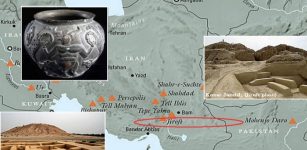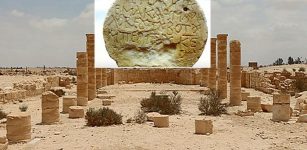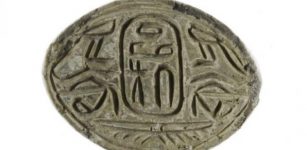Underground Labyrinth With Secret Passages, Tunnels In Dobrogea Plateau, Romania
A. Sutherland - AncientPages.com - In many cases, the world below us is just as fascinating as the ground we walk on. Across Europe, there is a hidden, often millennia-old subterranean realm of tunnels stretching from the north in Scotland leading down to the Mediterranean.
Limanu Cave's secret, and still unexplored passages and roads. The network gallery actually resembles a city street map, like the street network of an ancient city developed chaotically, thus the impression of an underground city. Image source
It is an underground world of never-ending tunnels, massive caves, and labyrinths dug by unknown ancient men. There are also underground labyrinths that have not been fully explored yet.
One is located about 52 kilometers from Constanța, historically known as Tomis, the oldest continuously inhabited city in Romania.
A Vast Underground City Where You Can Get Lost
This vast labyrinth of 12 hectares lies beneath the plateau of Limanu. Researchers started investigating the place in 1916 and discovered traces left by humans, carved walls and ceilings, and ancient ceramic fragments. Drawings and inscriptions in Roman and Cyrillic alphabets on the walls prove the cave was inhabited between the 1st century BC and the 10th century AD.
The labyrinth is vast, with a total length of passages of approximately 3.5 km. Dacians used it to hide from the Roman proconsul Marcus Licinius Crassus (c. 115 BC —53 BC), who played a vital role in transforming the Roman Republic into the Roman Empire. The cave's early inhabitants used a marking system to avoid getting lost.
Approximately 4,000 meters in length, Limanu Cave is the longest in Dobrogea. It has a chaotic branching of galleries, like the street network of an ancient city. Some researchers believe that at least some of the galleries were entirely dug by human beings, as there are tooling marks on the walls. Indeed, Limanu Cave represented an important human refuge, even since Dacian times.
The network of galleries resembles a city street map, like the street network of an ancient city developed chaotically, thus creating the impression of an underground city.
Remarkable Galleries
Some galleries have rectangular, very regular sections, and it seems humans carved them as signs of chiseling are visible. To avoid the collapse of ceilings, supporting walls and pillars were built in limestone slabs.
The drawings of galloping horses are of particular interest, while their riders have faces displayed from the front. Their silhouette and presentation resemble those of Dacian riders depicted on pottery discovered in many settlements inhabited by Thraco-Dacians.
This artwork belongs to the Roman-Byzantine period and the subsequent times. Other pictures show Christian religious symbols, letters, or words in the Cyrillic alphabet.
According to Ph.D. Adina Boroneant, "Vasile Pârvan" Institute of Archaeology, Romanian Academy, the Limanu Cave was a shelter for the local population until later, 10th-11th centuries AD.
Surveys have revealed archaeological material proving that local Dacians, even in that era, inhabited the cave. Existing evidence allows us to assume that a local Geto-Dacian authority ordered the maze of Limanu as a defense measure against the Roman danger." The account of Dio Cassius shows that the cave was a place of refuge, purposefully chosen and renovated, not some adventitious cavern," Ph.D. Boroneant writes in ”The Underground Labyrinth of Limanu” (”Labirintul subterrane de la Limanu”).
Tales Of Mysterious Sounds Coming From Underground Realms
Local stories mention strange and frightening wails like a prolonged high-pitched cry of grief, pain, or anger coming from the depths of the earth.
A scientific explanation for these strange sounds provided by speleologists is that the eerie wails are produced by the wind that sweeps through many underground galleries at Limanu. This noise affects the human psyche.
The cavern has a unique characteristic: although it is located on a complex of lakes and close to the Black Sea, it is so impenetrable that not even water can pass through.
The cave is also known as Caracicula (the old name of the Limanu settlement), Bats', or Icons' – due to some images carved in stone that once guarded the entrance.
Limanu Cave is one of the three habitats in Romania for horseshoe bats – Rhinolophus Mehelyi. The species decreased from over 5,000 specimens to about 300 individuals. However, ecologists warned about the vulnerability of the cave, which is a magnet for treasure hunters. Through their actions, they tend to destroy the fauna.
Being located near the border with Bulgaria, Limanu cave had the reputation of a tunnel carrying fugitives across the border, particularly during the communist time.
There are many reasons to suspect the Dobrogea caves are hiding mysteries still waiting to be discovered.
Written by – A. Sutherland - AncientPages.com Senior Staff Writer
Updated on February 10, 2023
Copyright © AncientPages.com All rights reserved. This material may not be published, broadcast, rewritten or redistributed in whole or part without the express written permission of AncientPages.com
Expand for referencesReferences:
Moscovich, M. James. “Cassius Dio’s Palace Sources for the Reign of Septimius Severus.” Historia: Zeitschrift Für Alte Geschichte 53, no. 3 (2004): 356–68.
More From Ancient Pages
-
 Mysterious Headless Skeleton May Be Sir George Yeardley – The Man Who Shaped Early America
Archaeology | Aug 11, 2018
Mysterious Headless Skeleton May Be Sir George Yeardley – The Man Who Shaped Early America
Archaeology | Aug 11, 2018 -
 Eduba: Scribal School In Ancient Mesopotamia
Ancient History Facts | Jun 29, 2016
Eduba: Scribal School In Ancient Mesopotamia
Ancient History Facts | Jun 29, 2016 -
 Evidence Ancient Civilizations Had Knowledge About Planets In Our Solar System Thousand Years Ago
Ancient Mysteries | Mar 10, 2021
Evidence Ancient Civilizations Had Knowledge About Planets In Our Solar System Thousand Years Ago
Ancient Mysteries | Mar 10, 2021 -
 Rare Archaeological Discoveries In The Sacred Animal Necropolis In Saqqara
Archaeology | Apr 26, 2020
Rare Archaeological Discoveries In The Sacred Animal Necropolis In Saqqara
Archaeology | Apr 26, 2020 -
 Ancient Stone Ram Figurine – Symbol Of Abundance And Great Courage – Unearthed In Old Cemetery
Archaeology | Oct 2, 2020
Ancient Stone Ram Figurine – Symbol Of Abundance And Great Courage – Unearthed In Old Cemetery
Archaeology | Oct 2, 2020 -
 Ancient Intercontinental Underground Tunnels Built By Survivors Of A Great Catastrophe And The Snake God Connection
Ancient Mysteries | Jul 4, 2018
Ancient Intercontinental Underground Tunnels Built By Survivors Of A Great Catastrophe And The Snake God Connection
Ancient Mysteries | Jul 4, 2018 -
 Early Māori Settlement On The Subantarctic Islands -Uncovering Some Of The Unknown
Archaeology | Jul 20, 2023
Early Māori Settlement On The Subantarctic Islands -Uncovering Some Of The Unknown
Archaeology | Jul 20, 2023 -
 Ancient Burials Of World’s First Horse Riders Found Near The Black Sea
Archaeology | Mar 3, 2023
Ancient Burials Of World’s First Horse Riders Found Near The Black Sea
Archaeology | Mar 3, 2023 -
 Jiroft’s Konar Sandal – Home To A Huge Ziggurat And Many Ancient Treasures
Featured Stories | Jun 8, 2021
Jiroft’s Konar Sandal – Home To A Huge Ziggurat And Many Ancient Treasures
Featured Stories | Jun 8, 2021 -
 Michael Scott – Fascinating Wizard Who Tutored The Holy Roman Emperor Frederick II
Featured Stories | Mar 7, 2025
Michael Scott – Fascinating Wizard Who Tutored The Holy Roman Emperor Frederick II
Featured Stories | Mar 7, 2025 -
 Beautiful Gold ‘Lynx’ Earrings Discovered In The Ruins Of The Ancient Lost City Of Ani Go On Display In 2023
Archaeology | Dec 29, 2022
Beautiful Gold ‘Lynx’ Earrings Discovered In The Ruins Of The Ancient Lost City Of Ani Go On Display In 2023
Archaeology | Dec 29, 2022 -
 Rare Discovery: 530 Knuckle Bones ‘Astragali’ For Gaming And Divination Unearthed In Ancient City Of Maresha
Archaeology | Aug 16, 2022
Rare Discovery: 530 Knuckle Bones ‘Astragali’ For Gaming And Divination Unearthed In Ancient City Of Maresha
Archaeology | Aug 16, 2022 -
 Tombstone With Ancient Greek Inscription Unearthed Near Nitzana In The Negev, Israel
Archaeology | Jan 8, 2021
Tombstone With Ancient Greek Inscription Unearthed Near Nitzana In The Negev, Israel
Archaeology | Jan 8, 2021 -
 Oral Stories Of Australia’s First Nations Might Be 10,000 Years Old – Evidence Found
Archaeology | Aug 2, 2023
Oral Stories Of Australia’s First Nations Might Be 10,000 Years Old – Evidence Found
Archaeology | Aug 2, 2023 -
 Magical Dinas Emrys: Legendary Battle Of The Dragons And Merlin’s Hidden Treasure
Featured Stories | Jan 15, 2025
Magical Dinas Emrys: Legendary Battle Of The Dragons And Merlin’s Hidden Treasure
Featured Stories | Jan 15, 2025 -
 Deadly Catastrophe In Pompeii And An Overlooked Piece Of The Well-Researched Disaster
Archaeology | Jul 18, 2024
Deadly Catastrophe In Pompeii And An Overlooked Piece Of The Well-Researched Disaster
Archaeology | Jul 18, 2024 -
 “The Starving Of Saqqara Statue” And Its Undeciphered Inscription Could Pre-Date The Pyramids Of Egypt
Archaeology | Jun 2, 2014
“The Starving Of Saqqara Statue” And Its Undeciphered Inscription Could Pre-Date The Pyramids Of Egypt
Archaeology | Jun 2, 2014 -
 Traces Of Ancient Maya In Europe? Controversial Theory Examined
Ancient Mysteries | May 25, 2018
Traces Of Ancient Maya In Europe? Controversial Theory Examined
Ancient Mysteries | May 25, 2018 -
 Hyksos: 15th Dynasty Rulers Of Ancient Egypt, Were An Internal Takeover
Archaeology | Jul 15, 2020
Hyksos: 15th Dynasty Rulers Of Ancient Egypt, Were An Internal Takeover
Archaeology | Jul 15, 2020 -
 Evidence Of The 586 BCE Babylonian Destruction Of Jerusalem’s Monumental Building – Reconstructed
Archaeology | Jul 28, 2023
Evidence Of The 586 BCE Babylonian Destruction Of Jerusalem’s Monumental Building – Reconstructed
Archaeology | Jul 28, 2023

